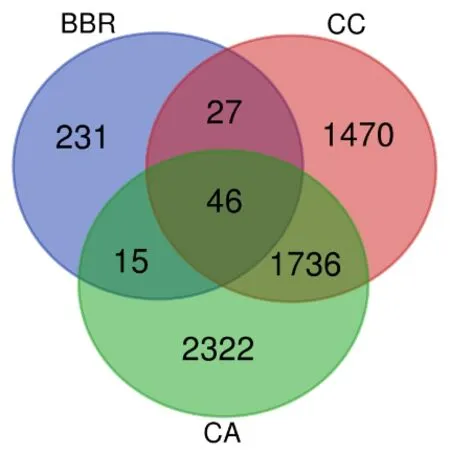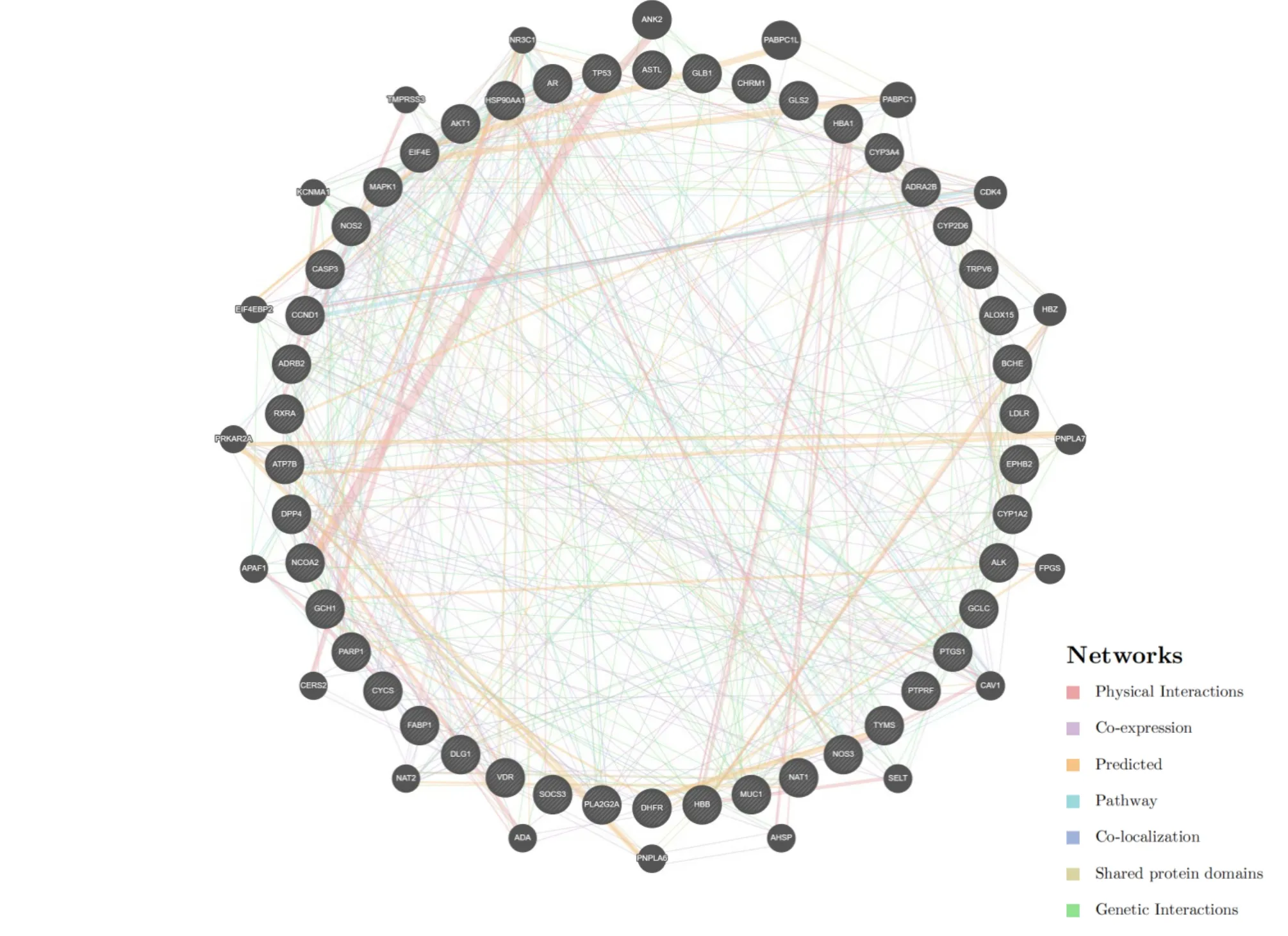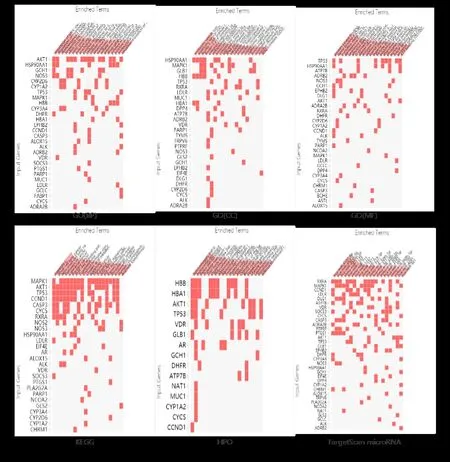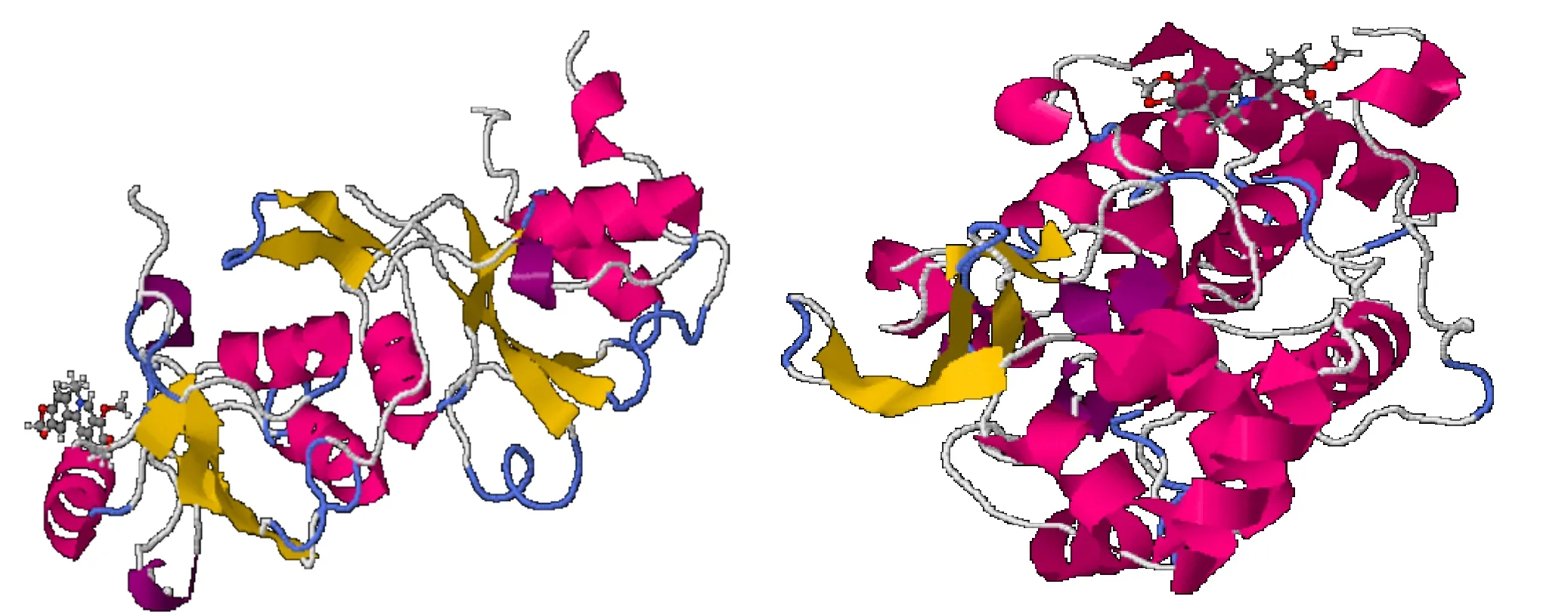Prediction of the mechanism of berberine in the prevention and treatment of colorectal adenoma cancerizat based on network pharmacology and molecular docking technology
Ting-Ting Chen,Ya-Bo Shi
1First Clinical Medical College of Nanjing University of Chinese Medicine,Nanjing 210046,China;2School of Pharmacy Henan University of Traditional Chinese medicine,Zhengzhou 450008,China.
Background:To predict the potential mechanism of prevention and treatment of colorectal adenoma canceration by berberine and the docking of main key targets by computer virtual method. Methods: The related targets of berberine,colorectal adenoma and colorectal cancer were collected in various databases;the key targets were obtained by intersection;the protein protein interaction network and 6 kinds of enrichment analysis of key potential targets were completed by corresponding databases;the main key targets and berberine molecules were obtained for molecular docking.Results: There were 319 unique targets for berberine,3,279 for intestinal adenoma and 4,119 for colorectal cancer.The protein protein interaction network of key target involved 66 proteins.In the results of Gene Ontology enrichment,28 items related to biological process,28 items related to cell composition,30 items related to molecular function,26 items related to Kyoto Encyclopedia of Genes and Genomes pathway enrichment,35 items related to TargetScan microRNA,15 items related to Human Phenotype Ontology.TP53 and CYCS are the 2 key targets involved in the system enrichment.After docking,berberine was closely bound to the α-helix and β-fold of TP53 protein,and to the α-helix of CYCS protein.Conclusion: The potential mechanism of berberine in the prevention and treatment of colorectal adenoma canceration may be related to the regulation of cell apoptosis,metabolic pathways and biological activities of various enzymes.berberine,as a small molecular ligand,has the characteristics of multi-target,multi-channel and multi-system mechanism.In the prediction results,berberine,as a small molecular ligand,can closely bind with the main key targets related to colorectal adenoma canceration.
Key words: Berberine,Colorectal adenoma,Colorectal cancer,Network pharmacology,Molecular docking,Mechanism research
Background
Colorectal cancer (CC) has ranked the third cause of cancer-related death in the world [1].Colorectal adenoma (CA) is the main precancerous lesion of CC,and relevant epidemiological data shows that the higher the incidence of adenoma,the higher the incidence of CC [2].At present,colonoscopy resection is the main treatment for CA,and there is no recognized oral medication standard scheme for preventing recurrence and canceration of CAtous polyps [3].In China,highquality clinical studies have proved that taking berberine (BBR) can safely and effectively reduce the risk of CA recurrence and canceration [4],but at present,the relevant mechanism research is not indepth,and there is no systematic mechanism research on the prevention and treatment of CA canceration by BBR.As a new and interdisciplinary subject,network pharmacology can quickly and systematically predict and analyze the mechanism of drug action [5].Therefore,this study intends to systematically analyze the targets of BBR in the prevention and treatment of CA cancer,and classify and enrich the related mechanisms of the main potential targets by using the network pharmacology technology,so as to provide new basis and ideas for systematically revealing the multi-target and multi-pathway prevention and treatment of CA cancer by BBR.
Materials and methods
Construction of corresponding target data set of BBR
Taking BBR as the research object,the corresponding targets were searched by TCMSP (tcmspw.com) with‘Berberine’ as the keyword.Search the Canonical SMILES information corresponding to Berberine in Pubchem (https://pubchem.ncbi.nlm.nih.gov/)database,enter Swiss Target Prediction (http://www.swiss target prediction.ch/) and STITCH Version 5.0(http://stitch.embl.de/) database to find the predicted targets of Homo sapiens,and select the target information with Probability 1 to form the dataset.Mining the target prediction library in SuperPred(http://prediction.charite.de/index.php?Site=chemdood le_search_target) and PharmMapper (http://www.lilabecust.cn/pharmmapper/) databases to find the corresponding data sets for aggregation and build a drug target database for BBR.
Construction of disease-related target database
CA,CC as the research object,relying on OMIM(https://omim.org/),TTD (http://db.idrblab.net/ttd/),PharmGkb (https://www.pharmgkb.org/),DiGSeE(http://210.107.182.61/geneSearch/) public database,retrieve the corresponding targets,find the corresponding data set for summary,construct the disease target database of the research object.
Data intersection of BBR and 2 disease-related targets
The corresponding targets of BBR,CA and CC were corrected and unified by Uniprot database(http://www.uniprot.org/).Bioinformatics &Evolutionary Genomics platform(http://bioinformatics.psb.ugent.be/webtools/Venn/)was used to extract the key targets from the intersection of the calibrated targets,and prepare for the association analysis of BBR with the corresponding common targets of CA and CC.
Construction of protein protein interaction network
To illustrate the role of relevant protein targets at the system level,gene names of key targets selected in 1.3 were uploaded to GeneMANIA database(http://genemania.org/) to obtain and analyze the protein protein interaction (PPI) network of protein interaction information.
Enrichment analysis based on Enrichr database
Enrichr database (http://amp.pharm.mssm.edu/Enrichr/) was used to enrich the Gene Ontology (GO)function of key potential targets,enrich the data related to Kyoto Encyclopedia of Genes and Genomes (KEGG)signaling pathway,analyze TargetScan microRNA and analyze the correlation between Human Phenotype Ontology (HPO),and predict the potential mechanism of the experienced prescription Xiaoai Jiedu recipe in the prevention and treatment of CA from the perspective of system biology.
Molecular docking between chemical structure and main functional targets of BBR
According to the enrichment analysis results in 1.5,the related targets in GO,KEGG,TargetScan microRNA and HPO analysis were intersected to extract the main key functional targets.TargetScan predicted the biological targets of miRNAs by searching for conserved 8mer,7mer and 6mer loci [6].The human phenotype HPO platform was mainly used for phenotypic-driven differential diagnosis and genomic diagnosis,and the ultimate goal was to improve the biomedical research model [7].BBR was docked with the main key targets on the SwissDock molecular docking platform (http://www.swissdock.ch/) [8].
Analysis results
Establishment of target database of research object
A total of 319 targets corresponding to BBR,3,279 unique targets corresponding to CA,and 4,119 unique targets corresponding to CC were collected.The target name was input into Uniprot(http://www.uniprot.org/uniprot) to obtain the human gene name corresponding to the target protein,and the corresponding gene name data set was formed.
Extraction of key research targets
The targets of the three research objects were crossed(Figure 1) to obtain 46 identical targets.From the perspective of targets,it is inferred that BBR has the characteristics of synergistic prevention and treatment of CA carcinogenesis through multiple targets.These 46 targets were set as the key potential targets for the prevention and treatment of CA carcinogenesis by BBR,which were prepared for the construction of PPI network and enrichment analysis.

Figure 1 Wayne diagram of Berberine recipe and the two diseases targets.BBR,berberine;CC,colorectal cancer;CA,colorectal adenoma.
Construction and analysis of PPI
There are 66 nodes in the protein interaction network obtained from 46 key targets (Figure 2).The nodes represent the related proteins,and each edge represents the interaction relationship between proteins.Physical Interactions and co-expression accounted for 38.15%and 29.28% of the total,17.19% for predicted protein interaction,7.12% for Pathway,6.57% for colocalization,1.61% for shared protein domains,and genetic interactions accounted for 0.09%.The results show that these proteins are at least biologically related,which pave the way for further enrichment analysis.

Figure 2 PPI network of key proteins. PPI,protein protein interaction.
Enrichment analysis based on Enrichr database
Enrichment analysis of key targets (Figure 3) showed that GO functional biological process mainly involved in the synthesis and metabolism of nitric oxide,monoterpene metabolism,arachidonic acid regulation,drug catabolism and endocytosis.Cell composition mainly involved in intracellular vesicles,ficolin-1-rich granules,mitochondria,lysosomes,RNA polymerase II transcription complex,nuclear chromosomes,chromatin,RISC complex,etc.Molecular function related items mainly involved protein kinase binding,heme binding,epinephrinebinding,amyloidβ binding,G protein coupling,mitogen activation protection,adrenergic receptor a,oxidoreductase activity,phosphatase binding,protease binding,ATP binding,etc.The enrichment results of signal pathway (KEGG)are mainly distributed in signal pathways such as hepatitis C,small cell lung cancer,CC,PI3K Akt signal,apoptosis,thyroid cancer,5-hydroxytryptamine synapse and arginine biosynthesis.HPO is mainly enriched in prostate tumors,polycythemia,testicular tumors,splenomegaly,hypochromic anemia,osteoporosis,hepatomegaly,leiomyosarcoma and arterial thrombosis.TargetScan microRNA enrichment results mainly include miR-4707-5,miR-4520a-5,miR-4520b-5,miR-1203,miR-1195,etc.The multi-group enrichment results of Enrichr database showed that BBR could play a role in the prevention and treatment of CA carcinogenesis in multiple mechanisms.
Molecular docking between chemical structure and main functional targets of BBR
The key targets TP53 and CYCS extracted in 2.5 were docked with BBR on the Swiss Target Prediction molecular docking platform.Because the closer the binding of protein and small molecules,the greater the energy released,the lower the G value;At the same time,the lower the FullFitness value is,the better the docking effect is [9],so the model with the lowest ΔG value is selected in the prediction model (Figure 4).

Figure 3 general diagram of enrichment analysis

Figure 4 molecular docking diagram of berberine with TP53 (left) and CYCS (right)
The targets involved in the above 6 enrichment results were crossed on the Bioinformatics &Evolutionary Genomics platform to obtain the main key targets TP53 and CYCS,which were prepared for the next molecular docking.
Berberine,as a ligand small molecule,was closely integrated with the α helix (red helix) and β folding(yellow folding) parts of TP53 protein (FullFitness?1270.80 (kcal/mol),Estimated ΔG ?7.27 (kcal/mol)).Berberine,as a small molecule ligand,tightly binds to the α helix of CYCS protein (FullFitness ?1502.30(kcal/mol),EstimatedΔG ?7.58 (kcal/mol)).The above contents provide some ideas for studying the active conformation and action mode of BBR in combination with the main key targets of CA carcinogenesis,and pave the way for further modification or design of new molecular drugs for the prevention and treatment of CA carcinogenesis.
Conclusion and thinking
BBR,as the main active ingredient extracted from rhizomes of Coptidis,has anti-inflammatory,antioxidant,prevention and treatment of precancerous lesions,regulation of tumor microenvironment,elimination of tumor stem cells and other traditional Chinese medicine treatment [10–11].In order to explore the mechanism of BBR in the prevention and control of CA canceration,based on a variety of public database platforms,combined with multi omics,the interaction between BBR and corresponding targets of CA and CC was analyzed.
The main key targets of BBR and disease-related targets include inducible nitric oxide synthase,oxidative metabolism enzyme,low density lipoprotein,retinol X receptor,serine/threonine protein kinase,human cytochrome C,p53 protein and so on.Previous studies have shown that BBR can inhibit the expression of inducible nitric oxide synthase protein induced by inflammation [12].Clinical repeated use of BBR can reduce the activity of CYP2D6 [13],and can reduce the blood lipid level of patients with hyperlipidemia by upregulating the liver low density lipoprotein receptor[14].BBR can inhibit the growth of colon cancer cells and other biological characteristics by binding to the ligand binding region of RXRα [15].On the other hand,it can also regulate the M1 polarization of colitis macrophages induced by DSS through AKT1/SOCS1/NF-κB signaling pathway [16].The results of a related study of pancreatic ductal carcinoma show that tumor cells treated with BBR can reverse the expression of miR-34a in cells lacking WT-TP53 [17].However,there are few studies on the mechanism of berberine intervention in diseases in the literature.Indepth mechanism research needs to be further promoted and improved.At present,there are some basic research directions that need to be further explored.
After analyzing the protein interaction,it was found that in addition to the main key targets closely related to BBR,CA and CC,the associated proteins also included silencing cell membrane anchor protein,cytoplasmic poly A-binding protein-like protein,cyclin-dependent kinase and adenosine deaminase.Therefore,it was speculated that BBR might affect other associated proteins while regulating the main key protein targets,so as to achieve the role of preventing and controlling CA carcinogenesis.In order to further illustrate the potential mechanism of BBR in the prevention and control of CA carcinogenesis in multi-omics,this study conducted multi-group enrichment analysis on the main key targets.Enrichment results mainly concentrated in the body enzyme activity,material and energy metabolism,a variety of cancer pathways and microRNAs.In recent years,microRNAs have been emphasized as potential biomarkers in the diagnosis,prognosis and prediction of treatment response in patients with CC [18].Among them,miR-1203 is closely related to metastasis regulation and prognosis in other cancers,but the research in CC has not been reported.Whether this micro-sugar nucleic acid is related to the occurrence,development and prognosis of cancer needs further experimental confirmation [19].In addition,the relationship between intestinal flora and tumor cells in patients with CC is also constantly confirmed.Host intestinal microRNAs can affect the growth and composition of intestinal microflora,and there is a high degree of correlation between them [20].However,further in-depth and clear research on the specific role of microRNA in the process of CA carcinogenesis by berberine still needs to be followed up.Although the prediction results are involved in nonpathological mechanisms such as transmembrane information transmission between cells and endogenous stimulus signals,it may also be that BBR indirectly acts on some mechanisms to achieve a balance between inside and outside the body,and thus achieve the purpose of disease prevention and control.
At present,clinical trials have shown that oral berberine can effectively prevent and control the recurrence and canceration of CA.However,the number of such literature is limited,and there is no indepth report on similar research results.Therefore,the results of this study can pave the way for further promoting the related mechanism research and subsequent confirmation.
To sum up,this study used network pharmacology method to systematically predict the mechanism of BBR on CA carcinogenesis through multi-targets and multi-pathways,combined with molecular docking technology,it provided the leading information and basis for further exploring the effective combination of BBR and the main target molecules in the prevention and control of CA canceration,and also provided reference for the study of the mechanism of action of traditional Chinese medicine compound with more complex components.
- Medical Data Mining的其它文章
- Precision nosology of contrast-induced acute kidney injury may have higher accuracy in predicting adverse outcomes:inspiration from the modified classification of AKI
- Exploring the mechanism of Qinghaobiejiatang in treating renal interstitial fibrosis based on network pharmacology
- Based on data mining,the study on the medication rule of Chinese patent medicine for constipation
- Mining the rules of acupoint selection and manipulation scheme of massage in reducing or substituting drug treatment of simple obesity based on association rules and entropy cluster analysis
- Herbal medicine prescribing patterns from contemporary famous old TCM doctors for treating coronary heart disease:an analysis based on data mining

